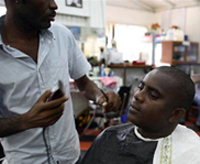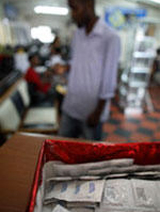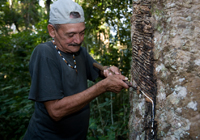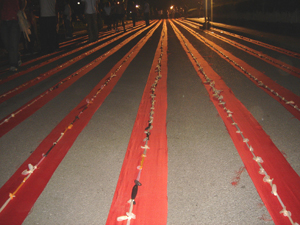
Photo: Daniel Delaunay
Thousands of condoms pile in the corner. Buckets of paint lie on the shelf. She cuts, twists, shapes, melts, pastes, colors, crochets and sculpts, with her fingers and nails stained black. 365 hours later, a colourful elegant gown made of 6,500 condoms debuts.
Adriana Bertini, a Brazilian artist living in São Paulo, uses expired or defective condoms as raw material to make pieces of art. Her creations include ornate evening dresses, vivid bikinis, elegant shawls, flowery carnival costumes, and other plastic arts.
"I want my art to be visible everywhere, reminding people of the necessity of HIV prevention" Bertini says. “I prefer working more with the figurines, because I noticed that they make people think about the meaning of ‘Wear against AIDS’.”
Bertini started her career at Brazil's fashion houses, and made her first dress from condoms in 1997. Since then, the designer has made around 200 sculptures, 80 tapestries and 160 figurines from condoms. The most condoms she has ever used on a gown - around 80 thousand - was on one wedding dress.
"My idea is to promote condom use not as a commercial fashion but as a conceptual fashion, be it conscious or subconscious. The idea is to wear them at the right time, not just as a trend, on clothes" says Bertini.
Bertini started working in HIV prevention in 1994, after she spent time with HIV positive children as a volunteer for GAPA, an HIV prevention group. "In the beginning, I worked with condoms but not necessarily in the context of AIDS," the designer says "The AIDS issue came along with my work with children living with HIV. I realized that I could use fashion for AIDS awareness."
“I volunteered to do the HIV prevention work,” says Bertini, who at the time did not know anyone living with HIV. “Then I made friends who were HIV positive and this stimulated me even more to promote prevention. Today, I have already lost some dear people to AIDS. I think this is the minimum I can do, being a conscientious person faced with a problem of this magnitude. ‘If you have conscience, act'.”

Adriana Bertini. Photo: Rodrigo Cibantos
Bertini’s designs can be seen at fashion shows and in magazines, or are exhibited in museums. “The focus is not on wearing my gowns, but on introducing condoms into everybody’s lives, breaking taboos and giving the public a chance to ponder.”
While Bertini’s designs are often shown in Brazil, she has also had important international exposure. Her work was exhibited at the International AIDS Conference in Barcelona, Spain, in 2002, and at the 15th International AIDS Conference in Bangkok, Thailand, in 2004, among others. She has also proposed an exhibit in the cultural programme of the 16th AIDS Conference in Toronto this coming August: “I am waiting for the selection to be finalized.”
Reactions of the public to her designs vary. Some people whisper about it, others laugh or dismiss it as inappropriate, and then there are those who want to meet her and tell her their problems.
“There a lot of parents who want to thank me because it was through my art that they’ve reached out to their children to talk about sexuality,” she says.
All her material comes from condom manufacturers, and the proceeds from the sales of dresses - prices range from $700 to $5,000 - go directly to organizations involved in the fight against AIDS. Bertini and her HIV-positive apprentices do not make their living directly from their work, but instead rely on sponsors.
"I'm not doing this to make money but rather as a social act, as art aimed at others. I hope that by using condoms to create something new, I can inspire reflection, foster discussion, and challenge taboos." says Bertini who is quickly becoming well-known in international activism circles.
The 34 year-old was awarded with the Nkosi Johnson Community Spirit Award in 2004 by the International Association of Physicians in AIDS Care, Washington DC, (IAPAC) in recognition of her 10 years of artistic activism. "You understand, condoms must become as basic as a pair of jeans and as necessary as a great love," Bertini emphasizes.
Related links
Adriana Bertini official website

















